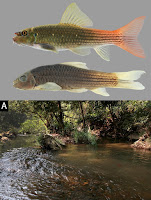[Most Recent Entries] [Calendar View]
Saturday, July 1st, 2023
| Time | Event | ||||
| 2:19a | [Paleontology • 2023] Rhigerpeton isbelli • A New lapillopsid from Antarctica and A Reappraisal of the Phylogenetic Relationships of early Diverging stereospondyls (Temnospondyli: Stereospondyli: Lapillopsidae)
ABSTRACT Stereospondyls underwent a global radiation in the Early Triassic, including an abundance of small-bodied taxa, which are otherwise rare throughout the Mesozoic. Lapillopsidae is one such clade and is presently known only from Australia and India. This clade’s phylogenetic position, initially interpreted as micropholid dissorophoids and later as early diverging stereospondyls, remains uncertain. Although the latter interpretation is now widely accepted, lapillopsids’ specific relationship to other Early Triassic clades remains unresolved; in particular, recent work suggested that Lapillopsidae nests within Lydekkerinidae. Here we describe Rhigerpeton isbelli, gen. et sp. nov., based on a partial skull from the lower Fremouw Formation of Antarctica that is diagnosed by a combination of features shared with at least some lapillopsids, such as a longitudinal ridge on the dorsal surface of the tabular, and features not found in lapillopsids but shared with some lydekkerinids, such as the retention of pterygoid denticles and a parachoanal tooth row (as in Lydekkerina, for example). A series of phylogenetic analyses confirm the lapillopsid affinities of R. isbelli but provide conflicting results regarding the polyphyly and/or paraphyly of Lydekkerinidae with respect to lapillopsids. The position of Lapillopsidae within Temnospondyli is highly sensitive to taxon sampling of other predominantly Early Triassic temnospondyls. The occurrence of a lapillopsid in Antarctica brings the documented temnospondyl diversity more in line with historically well-sampled portions of southern Pangea, but robust biogeographic comparisons remain hindered by the inability to resolve many historic Antarctic temnospondyl records to the finer taxonomic scales needed for robust biostratigraphy. Bryan M. Gee, Charles V. Beightol and Christian A. Sidor. 2023. A New lapillopsid from Antarctica and A Reappraisal of the Phylogenetic Relationships of early Diverging stereospondyls. Journal of Vertebrate Paleontology. e2216260. DOI: 10.1080/02724634.2023.2216260 | ||||
| 2:27a | [Ichthyology • 2023] Garra panitvongi • Species of Garra (Cypriniformes: Cyprinidae: Labeoninae) in the Salween River Basin with Description of An Enigmatic New Species from the Ataran River Drainage of Thailand and Myanmar
Abstract Garra panitvongi, new species, is described from the Ataran River drainage, Salween River basin, of southeastern Myanmar and western Thailand. It is the sixth species of Garra known from the Salween River basin and is readily distinguished from all congeners by the red-orange color of the body and caudal fin, and a pointed proboscis with a blue stripe on each side from the anterior margin of the orbit to the tip of the proboscis and with the stripes forming a V-shape. Garra panitvongi is known in the aquarium trade as the Redtail Garra. Descriptive information is provided on poorly known species of Garra in the Salween River basin, and Garra nujiangensis is transferred to Ageneiogarra. Key words: Actinopterygii, teleost, phylogenetics, Zami River
Garra panitvongi, new species Redtail Garra, ปลาเลียหินหางแดง Diagnosis. Garra panitvongi is easily distinguished from all other species of Garra by the red-orange color of the caudal fin and posterior one-fourth of the body (Fig. 3), and a pointed proboscis with a blue stripe on each side from the anterior margin of the orbit to the tip of the proboscis and with the stripes forming a V-shape (Fig. 4). It further differs from G. notata and G. salweenica, the only other species of Garra in the Salween River basin with a proboscis, by lacking conspicuous black spots at the base of the dorsal fin and large black spots or bands on the caudal fin. It further differs from G. salweenica in having fewer pectoral rays (14–15 vs.17–18). Etymology. The specific name panitvongi, a noun in genitive case, is applied in recognition of the tremendous contributions made by Dr. Nonn Panitvong to our knowledge of fishes of Thailand, in particular through his book, “A Photographic Guide to Freshwater Fishes of Thailand” (Panitvong 2020). facebook.com/ThaiFishBook Weerapongse Tangjitjaroen, Zachary S. Randall, Sampan Tongnunui, David A. Boyd and Lawrence M. Page. 2023. Species of Garra (Cyprinidae: Labeoninae) in the Salween River Basin with Description of An Enigmatic New Species from the Ataran River Drainage of Thailand and Myanmar. Zootaxa. 5311(3); 375-392. DOI: 10.11646/zootaxa.5311.3.3 |
| << Previous Day |
2023/07/01 [Calendar] |
Next Day >> |










